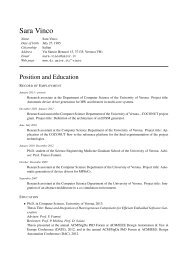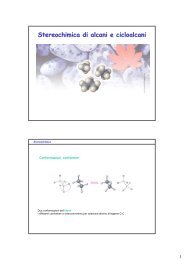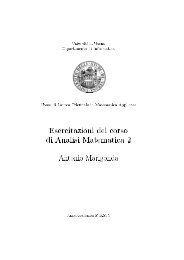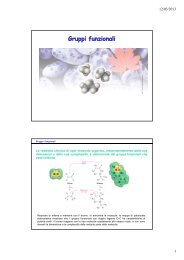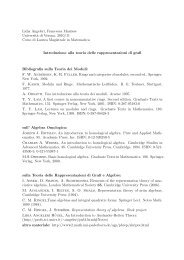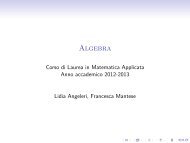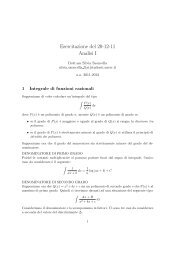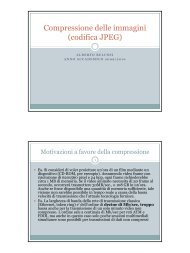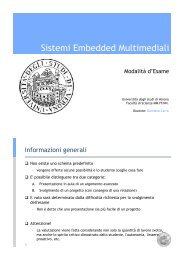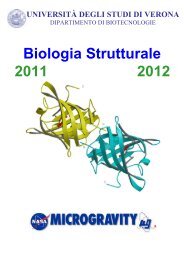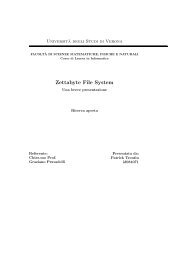You also want an ePaper? Increase the reach of your titles
YUMPU automatically turns print PDFs into web optimized ePapers that Google loves.
<strong>10</strong>4 21. INTEGRALI CURVILINEI, TEOREMA DI STOKES, FORMULE DI GAUSS-GREEN - CONTINUAZIONE<br />
Esercizio 21.2. Sia S la superficie data dal grafico della funzione z = xy/2 tale che x 2 + y 2 ≤ 12. Si calcoli<br />
l’area di S e il flusso del campo F = (x, y, 1) attraverso S orientata in modo che la normale sia rivolta verso<br />
l’alto.<br />
Svolgimento. La superficie S è un grafico z = f(x, y) f : D → R, con f(x, y) = xy/2 e D := {(x, y) ∈<br />
R 2 : x 2 + y 2 ≤ 12}. D è il cerchio centrato nell’origine di raggio √ 12 = 2 √ 3. Essendo un grafico, sappiamo già<br />
che l’elemento di superficie è dσ = 1 + |∇f| 2 quindi<br />
dσ =<br />
<br />
1 + y2<br />
4<br />
+ x2<br />
4<br />
1<br />
= 4 + y2 + x2 .<br />
2<br />
Verifichiamo il risultato. S è parametrizzata da ψ(x, y) = (ψ1, ψ2, ψ3) = (x, y, f(x, y)) = (x, y, xy/2). La<br />
matrice Jacobiana della parametrizzazione è:<br />
⎛<br />
Jac ψ(r, z) = ⎝<br />
1 0<br />
0 1<br />
y/2 x/2<br />
Per la regola di Binet, per trovare l’elemento di superficie 2-dimensionale dobbiamo considerare tutti i minori<br />
di ordine 2, e sommarne i quadrati dei determinanti estraendo la radice.<br />
ω2(∂xψ, ∂yψ) =<br />
A questo punto si ha:<br />
<br />
det 2<br />
<br />
Area(S) =<br />
1 0<br />
0 1<br />
S<br />
<br />
dσ =<br />
<br />
+ det 2<br />
<br />
1 0<br />
y/2 x/2<br />
D<br />
<br />
1 + x2<br />
4<br />
+ y2<br />
4<br />
⎞<br />
⎠<br />
<br />
+ det 2<br />
<br />
0 1<br />
y/2 x/2<br />
<br />
= 1 + x2<br />
4<br />
<br />
1 <br />
dxdy = 4 + y2 + x2 dxdy.<br />
2 D<br />
+ y2<br />
4 .<br />
Per calcolare questo integrale passiamo in coordinate polari piane x = ρ cos θ, y = ρ sin θ, ricordando che il<br />
determinante Jacobiano di questa trasformazione è ρ:<br />
Area(S) =<br />
2π 12<br />
= π<br />
2<br />
0 0<br />
148<br />
4<br />
1<br />
<br />
4 + ρ2 ρ dρ dθ = π<br />
2<br />
√ t dt = π<br />
2<br />
= 8<br />
3 π (37√ 37 − 1).<br />
t 3/2<br />
3/2<br />
t=148<br />
t=4<br />
12<br />
0<br />
4 + ρ 2 ρ dρ = π<br />
2<br />
144<br />
= π<br />
3 (√ 148 3 − 8) = π<br />
3 (√ 4 3 37 3 − 8)<br />
0<br />
√ 4 + w dw<br />
Calcoliamo la normale a S. Posto G(x, y, z) = z − f(x, y) = z − xy/2, la superficie risulta rappresentata<br />
dall’equazione G(x, y, z) = 0, quindi la sua normale un<strong>it</strong>aria sarà data da<br />
± ∇G (−y/2, −x/2, 1) (−y, −x, 2)<br />
= ± = ± ,<br />
|∇G| |(−y/2, −x/2, 1)| x2 + y2 + 4<br />
e poiché l’esercizio richiede che la normale punti verso l’alto, sceglieremo<br />
ˆn(x, y, z) = (n1, n2, n3) =<br />
(−y, −x, 2)<br />
x 2 + y 2 + 4 ,



